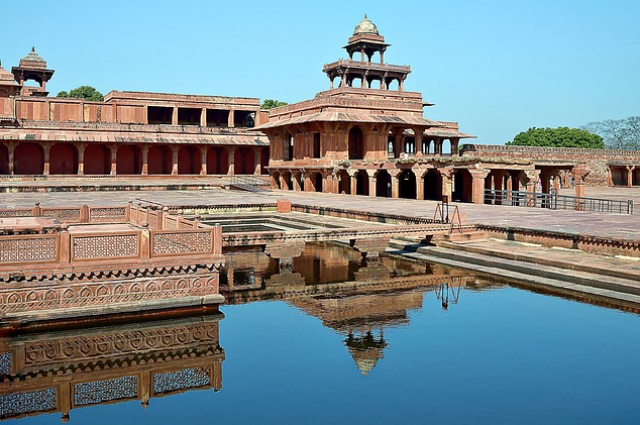
Image by Makalu from Pixabay
Birth of a Dream -Akbar and the idea of a Capital
Not many monarchs dared to dream as Akbar did in the huge canvas of history. It was around the year 1571 when the Mughal emperor, who was a visionary person and a person of an unsettled mind, decided to lay down a city not only as his political capital but as an ideal, a city where the man was strong and yet spiritual, the ruler bowed to the person of wisdom. This desire to see something new and different led to the creation of Fatehpur Sikri, which was chiselled out of a ridge of red sandstone at the foot of the simple village of Sikri.
Akbar called it (the city of victory), which is quite a loaded title. It was the new beginning, the outcry. He had imagined a world in which poets would stroll along with the scholars, warriors would hear the sages speak and in which religions would be able to agree under the same skies.
The Saint and the Emperor: Godliness underneath the Foundations
A prophecy was the beating of the city. Not having had a son is what had made Akbar approach the threshold of Sheikh Salim Chishti, the Sufi saint who made him father a long-awaited heir. In appreciation, Akbar based his capital in the area of the dwelling of this saint, making Fatehpur Sikri as much a shrine to God as it was to the secular authority it served.
Even today, the white marble tomb of Salim Chishti stands out softly in the red sandstone as a spiritual lighthouse. Visitors to the place continue to offer prayers there by tying threads to lattice windows in the hope of a piece of that ancient magic.
Breathing architecture: Grandeur of Red Sandstone
The architecture of the city is alive even in ruins. The sandstone walls, the fine jali screens, and the elaborate carvings: they not only define space, they tell stories. And each pillar, each arch is a verse in the great poem of Akbar.
The Islamic, Hindu, and Persian architecture blended since the emperor wanted to find unity in the world, and this was the materialisation of his ideology that one religion or civilisation can have all the solutions. This is where the diversity of the world turned into a common song.
Buland Darwaza and Beyond: Architecture of Accommodation and Faith
Nobody will stand in front of the Buland Darwaza and feel small without being awed. This 54-meter gateway is more than a construction of the rock but rather a triumph, proclamation and vision. It was constructed to honour the victory of Akbar in Gujarat, but it was also a symbolic step that led between the ordinary matters and divine things, so the travellers entered not only the city but the empire of thoughts.
Each of the other monuments-the Diwan-i-Khas with its central pillar of fame, the Panch Mahal with its high-reaching terraces, the palaces of the queens, choosing to walk gently-seems to have a tale to tell, a breath of a past we have long since destroyed, and cannot forget.
Courtyards of Quiet: City Life in the Royal Walls
Think of the courts where the courtiers met, where the music went singing up through the air, and jasmine scents were at dusk. The stones do not forget laughter and the rustle of silk and murmurings of debates, which created a nation.
Empty as they are, they tell a story of an animated life that once lived--of strength tamed with verse, of a man in charge who cared not only to conquer but to communicate.
The Shrine of Salim Chishti: The spiritual pulse of a City
The heart of Fatehpur Sikri is the tomb of Salim Chishti, which is glistening with faith in its marble walls. This was where Akbar found the spiritual advice, and it is still a spiritual place where time stands still. Even the pilgrims and tourists still seek refuge under its latticed windows, where one part of the prayers merges with the wind.
This shrine was the spirit out of which the city grew; the silent centre under its reigning ambition.
The reason why Fatehpur Sikri went silent. The Riddle of Its Desolation
But the life of Fatehpur Sikri turned out to be, unfortunately, short. The city was a desert that had been deserted after barely fifteen years since it came into being. Technical versions lay the blame on water shortage- an ironic tragedy of a city created out of hope. Others opine that its position as a location far away from trade routes was a strategic drawback, hence unsustainable.
Yet its curtains of silence hint at more again, of a tale about a city too beautiful to accommodate the incumbent realities of empire, a city that lived between fantasy and tragic need, probably never intended to make it beyond the opening paragraph.
Whispers of the Past: What the Ruins Yet Tell Us Today
Now, as you walk through Fatehpur Sikri, you do not merely hear the echo of steps. In ruin, you perceive liveliness, you can sense the past, and you can read a poem. The city reminds us that the tales do not die down with silence.
The remains of it teach us, friends, that glory is only a thing that lasts a moment, that beauty and ambition may be both perpetual and evanescent.
Fatehpur Sikri in the Modern Memory: Preservation and Decay
Fatehpur Sikri is a fragile treasure today despite being a UNESCO World Heritage site. The elements and time, plus the tourists, pose threats to its whispers. But to those who listen, the city has not lost its soul, just lying in wait to tell its story yet again.
The city, which dared to dream, is called Fatehpur Sikri, and it will always stay young-just a mute testimony of how beautiful some stories are-how unfair some endings are.
